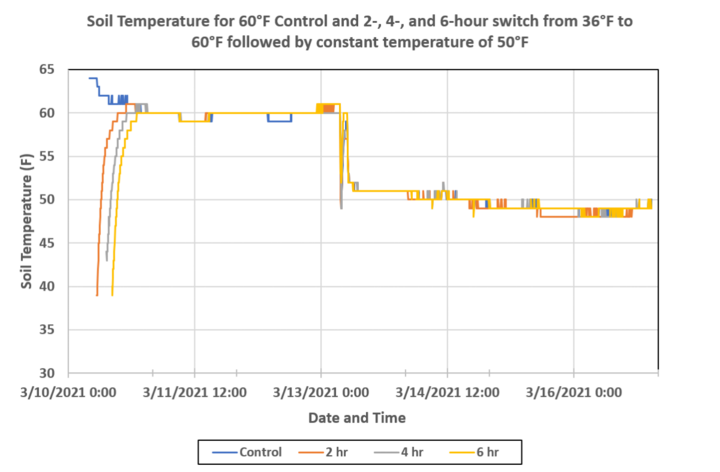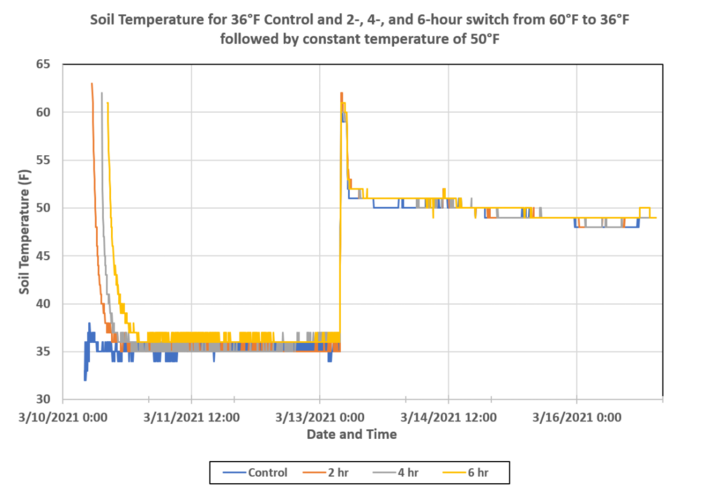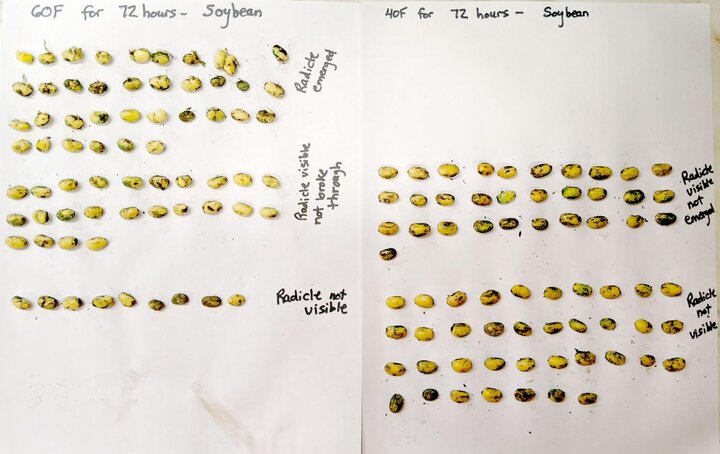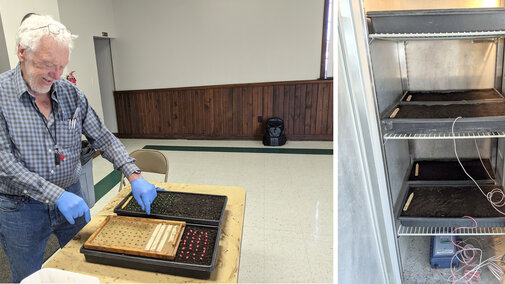When to start to plant can often be a difficult decision. The challenges include weather-related changes, soil temperature, moisture conditions, number of acres to cover and the risk of a spring frost for the earliest planted fields. We have recommended starting soybean planting as early as mid- to late April based on scientific reports that document higher yields (Tenorio et al., 2016). Advancing the soybean planting date window to match the corn planting date window would require using two planters, but some growers opt to plant soybeans before corn. In a recent post, Conley recommended planting soybean 7-10 days prior to planting corn (assuming the ground is fit to plant and the crop insurance date is taken into account).
Soybean growers frequently ask these questions:
- “If the soil temperature is less than 50°F (in the 40’s), yet on a warming trend, can I safely plant my beans without risk of chilling injury?”
- “How many hours after planting have to occur before an anticipated cold snap to avoid chilling injury to beans?”
To better address these questions, we decided in March to initiate indoor and outdoor studies to demonstrate the elements of the timing and duration of the critical imbibition water uptake phase for soybean. This article shares what we found in our indoor demonstration.
Introduction and Recap
A year ago, we wrote an article regarding understanding the soybean germination process. To recap, water uptake in a germinating seed occurs in two successive phases: imbibition and osmotic. The imbibition phase is an initial temperature-sensitive period of fast water uptake that results in the hydration of cellular membranes to functional state. Cold soil temperatures (e.g., a cold rain just after planting) can result chilling injury (or death). Once the imbibitional phase ends, the risk of chilling injury also ends. We previously noted that this begin-end time period is typically less than 24 hours. Bohner (2003) noted that the imbibitional phase could be completed in as little as 6-24 hours if the soil temperature was kept at 45°F. McDonald Jr. et al. (1988) observed that the presence of an intact seed coat extended the duration of the imbibition phase to eight hours.
The second slower water uptake phase — known as osmotic — begins after the end of the imbibition phase. Seedlings in this phase are quite tolerant of soil temps as low as 35-40°F, although those temps can be expected to lengthen the time from germination to emergence. This delay can, of course, lead to greater soil-borne pathogen problems, particularly if the soils are both wet and cold. Otherwise, germinated soybean seeds can grow slowly (i.e., assume a sort of “dormant” state) for several weeks until warmer soil conditions return and lead to emergence.
We also shared that replicated research on the interaction of soil temperature (40-50°F) and the duration of hours needed for imbibitional water uptake was needed. Such research could provide valuable data for soybean producers scheduling April planting as a means of widening the planting window to adapt to and take advantage of earlier and warmer springs.
Indoor Demonstration
This demonstration was performed with no treatment replications due to cooler space and time restrictions at the York County Fairgrounds. We hope to replicate this in the future. Our method is shared in the event others wish to replicate this. One cooler had a fixed setting of 60°F, while the other was a refrigerated cooler with a fixed setting of 36°F. Trays were filled with 2” of topsoil that we sieved to remove large particles.
The soil in the trays was brought to a field capacity soil moisture content. An equal number of the soil-filled trays was placed in each of the 36°F and 60°F coolers for an overnight equilibration to bring the soil to those temperatures prior to planting corn and soybean seed the next day. Seventy-two seeds of corn (P1716Q) and soybean (P28A42X at 9.1% seed moisture) were planted into each tray at 1.5” depth on March 10, 2021.
To assess the impacts of timing and duration of low-temperature-induced chilling injury, a designated pair of trays — one in each cooler — were swapped between coolers. This was done at 2-, 4-, 6-, 8-, 10-, 12-, and 48-hours post-planting. Soil temperature probes were placed in the control, 2-, 4-, and 6-hour tray pairs to determine how long it took for the soil in swapped trays to re-equilibrate from a 60°F to 36°F (and vice-versa) temperature switch (Figure 1).
- March 13 (72 hours after planting), trays were removed from both coolers and placed in a constant 50°F temperature room, which was expected to be conducive for the development of any seedlings that survived a timing/duration of a 36°F chilling treatment. No watering of trays was needed due to minimal soil water evaporation at this temperature.
- March 19 (9 days after planting), all trays were moved to a higher constant 60°F room to better simulate later spring temperature pattern that was more conductive to emergence. Watering was applied as needed the remainder of the demonstration.
- March 21 (11 days after planting), seedling emergence first noted, with daily emergence counts made thereafter.
- April 8 (29 days after planting), with no more seedling emergence, the experiment was terminated.
Two “dig up” trays were also planted and remained for 72 hours at 36°F and 60°F. When the trays were moved to the 50°F environment on March 13, these “dig up” trays were used to determine beginning germination after this time-period at those temperatures.


Indoor Demonstration Results

For purposes of this article, only the soybean results will be shared and discussed.
When photographing the seeds in the “dig up” trays, they were aligned into three classes: (a) seeds with the radicle thrust through the seed coat, (b) seeds with the radicle not quite yet bursting through the seed coat, and (c) seeds with no apparent radicle development (Figure 2). The majority of the soybean seed had swelled in both the 60°F and 36°F trays, but in the latter, no class (a) seeds with radicles breaking through the seed coat were evident. Roskruge and Smith (1977) showed that imbibitional water uptake is faster with warmer compared to cooler temperatures. The swollen seeds with lack of radicle development in our demonstration show how the soybean can uptake water during the imbibitional phase yet remain in a “dormant” state at lower temperatures (35-40°F) in the osmotic phase of germination.
First emergence was observed on March 21 in the 60°F control tray (Figure 3). Emergence of soybean was determined when the hypocotyl hook was visible at the soil surface.
The data showed similar emergence (69 to 78%) for soybean in the 60°F control (leftmost bar cluster), and for soybean that began at 60°F for at least eight or more hours before being switched to 36°F (fifth through the eighth bar clusters). Clearly, emergence was lessened in proportion to the timing at which soybean was switched from an initial 60°F to 36°F within 2-6 hours post-planting (upward-sloping trend line for second through fifth bar clusters). This would suggest that the critical period for imbibition occurs within the first eight hours. Thereafter, a switch from 60F to 36°F had little effect on soybean emergence (plateau line).

Not surprisingly, emergence was zero when soybean was in the 36°F control for 72 hours. Switching from two hours of 36°F exposure to 60°F resulted in only about 35% of the seedlings emerging; delaying the switch to ever later times resulted in even fewer seedlings emerging (i.e., only 4% in the rightmost bar cluster). We would never recommend planting soybean into 36°F soil. That temperature was an arbitrary choice because the available cooler could be set only to that temperature. We speculate that emergence after two hours of, say, 40°F or 45°F (instead of 36°F) might have led to less chilling injury emergence loss.
Discussion
In conclusion, let’s revisit the two questions:
Q: “If the soil temperature is less than 50°F (in the 40’s) yet on a warming trend, can I safely plant my beans without risk of chilling injury?”
A: Most likely, but it will depend. Additional research has shown that soybean seed quality (seed coats cracked, etc.), seed moisture (less than 13%) at planting, variety and soil moisture (saturated/soggy) all influence chilling injury risk as well. While the 36°F temperature is lower than we would ever recommend planting soybean seed, it did show an increase in soybean emergence when soybean was placed in warming conditions within the first 2-6 hours (from 36°F to 60°F). Note that it did take time for the soil to equilibrate, thus these two-hour incremental durations are not quite that precise.
From soybean field demonstrations planted into 40-plus degree soils on a warming trend during the day, we speculate that emergence after two hours of, say, 40°F or 45°F (instead of 36°F) might lead to less chilling injury emergence loss. Boehner (2003) suggested the imbibitional phase in soybean may be completed in 6-24 hours if the soil temperature was kept at 45°F, suggesting that planting into trending warmer soil temperatures could be a safe strategy.
Q: “How many hours do I have before an anticipated cold snap to avoid chilling injury to beans?”
A: Boehner’s study showed 6-24 hours at a temperature of 45°F. Specht showed around eight hours from Boehner’s dataset in a table found in this article. Our indoor demonstration showed at least eight hours based on non-replicated emergence data where the reduced emergence, as a result of chilling injury, occurred in the first 2-6 hours when soybean seed at 60°F was switched to 36°F. Boehner also noted it could be wise to plant around mid-day when the soil temperature is the warmest to get a warmer timeframe after planting than just before sundown.
These observations help explain other situations observed in the field. Specht planted soybean at mid-day into moist soil on various days in April 2019. On April 10, 2019, soybean seed planted mid-day prior to a cold snap had no difference in germination and emergence compared to other planting dates. In 2020, two Nebraska on-farm research studies in Seward County (see pg. 24-25), were planted within 24 hours of a cold snap. One was on April 15, 2020 at a soil temperature of 50°F prior to 5” of snow within 24 hours (first snow fell eight hours post-planting) with 86% of planted stand count at harvest. Another study was planted April 11, 2020 at a soil temperature of 50°F prior to a cold snap over the weekend, again with 86% of planted stand count at harvest. The grower wasn’t advised to plant prior to these conditions, but he knew his fields and that the soil conditions were right at planting time for his situation.
We hope to replicate this study in the future for more concrete data.
The authors wish to thank the York County Agricultural Society for the use of their coolers, and Jed Erickson for the soybean and corn seed. Jenny also wishes to thank Jim for all his hard work and help with this study in spite of being retired!
References
Bohner, Horst. 2003. Do Soil Temperatures at Planting Impact Soybean Yield?, Ontario Ministry of Agriculture, Food and Rural Affairs.
Bramlage, W.J., A.C. Leopold, and D.J. Parrish. 1978. Chilling Stress to Soybeans During Imbibition. Plant Physiology 61:525-529.
Conley, Shawn. April 11, 2021. Just the facts, Jack: planting date, planting rate and seed treatment recommendations. CoolBean blog.
Obendorf, R.L. and P.R. Hobbs. 1970. Effect of Seed Moisture on Temperature Sensitivity During Imbibition of Soybean. Crop Science 10:563-566.
McDonald Jr., M.B., C.W. Vertucci, E.E. Roos. 1988. Seed Coat Regulation of Soybean Seed Imbibition. Crop Science 28:987-992
Rees, Jenny and Jim Specht. April 9, 2020. Understanding the soybean germination process for early planted soybean decisions. UNL CropWatch.
Roskruge, C.L. and M.T. Smith. 1997. Journal of Plant Physiology 151:620-626.
Specht, James, Jenny Rees, Roger Elmore, Nathan Mueller, Keith Glewen. Soybean Germination/Emergence with April Planting Dates Relative to Coincident Air and Soil Temperatures in April and May, University of Nebraska Extension CropWatch, May 16, 2019.
Specht, James, Patricio Grassini, Jenny Rees, Nathan Mueller, and Roger Elmore. Amplifying Positive Impacts of Early Soybean Planting, University of Nebraska Extension CropWatch. April 19, 2018.
Specht, Jim, Greg Kruger, Jenny Rees, Roger Elmore, Patricio Grassini, Keith Glewen, and Tom Hoegemeyer. Corn, Soybean Planting Considerations for this Week’s Cold Snap, University of Nebraska Extension CropWatch. April 24, 2017.
Specht, Jim, Jenny Rees, Roger Elmore, Nathan Mueller, Keith Glewen. Considerations when Planting Soybean Early, University of Nebraska Extension CropWatch, April 25, 2019.
Tenorio, Fatima Amor, Patricio Grassini, Jenny Rees, Keith Glewen, Nathan Mueller, Laura Thompson, and Jim Specht. April 2016. Early Bird Gets the Worm: Benefits of Early Soybean Planting, University of Nebraska Extension CropWatch. April 20, 2016
Thompson, Laura et al. 2020. Nebraska Extension On-Farm Research Results 2020. University of Nebraska-Lincoln. pg. 24-25.
Tully, R.E., M.E. Musgrave and A.C. Leopold. 1981. The seed coat as a control of imbibitional chilling injury. Crop Science 21:312-317.

